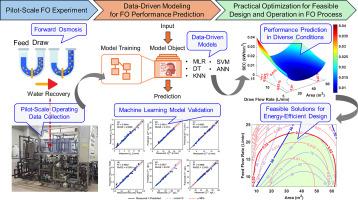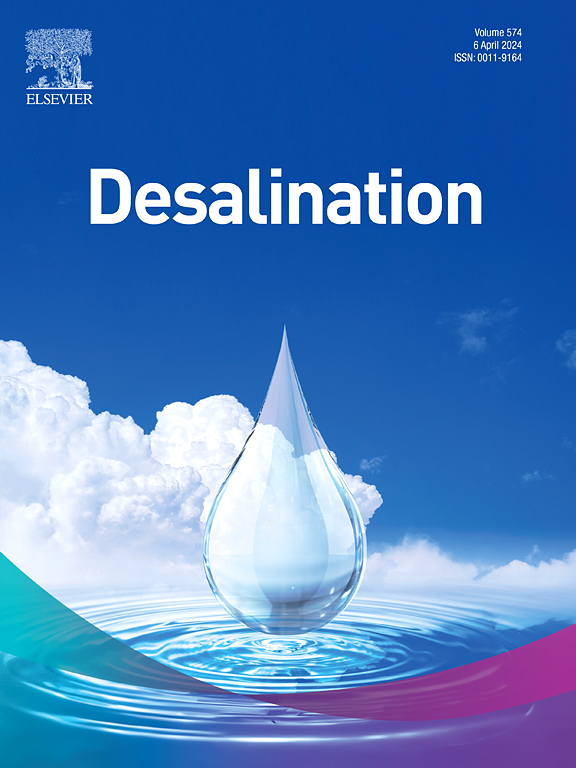Predicting and optimizing forward osmosis membrane operation using machine learning
IF 8.3
1区 工程技术
Q1 ENGINEERING, CHEMICAL
引用次数: 0
Abstract
Forward osmosis (FO) utilizes a draw solution to transport water across a semipermeable membrane, offering energy-efficient water treatment and resource recovery. This study explores machine learning models to predict FO performance at pilot scale, overcoming the limitations of traditional mathematical models in terms of computational load and time. By analyzing data from FO pilot experiments, we compare various algorithms, including multiple linear regression (MLR), support vector machine (SVM), k-nearest neighbor (KNN), decision tree, and artificial neural networks (ANNs). Among these, ANN was evaluated as most suitable and further optimized with input features of the permeate flux, membrane area, feed and draw solution flow rates, and feed and draw solution concentrations. The optimized ANN model demonstrated high accuracy for water flux prediction, with R2 values of 0.9886 and RMSE values of 0.3498 Lm−2 h−1. Additionally, an ANN model is developed to predict operating pressures under various FO operation conditions. By integrating FO water flux and operating pressure predictions, our model identifies optimal operating conditions that balance specific energy consumption and water recovery. Our findings offer insights and practical guidance for process engineers to efficiently design and operate FO systems to minimize energy consumption and maximize recovery.

利用机器学习预测和优化正渗透膜的运行
正渗透(FO)利用汲取溶液将水通过半透膜输送,提供节能的水处理和资源回收。本研究探索了机器学习模型,以预测中试规模的 FO 性能,克服了传统数学模型在计算负荷和时间方面的局限性。通过分析 FO 中试实验的数据,我们比较了多种算法,包括多元线性回归(MLR)、支持向量机(SVM)、k-近邻(KNN)、决策树和人工神经网络(ANN)。其中,人工神经网络被认为是最合适的,并根据渗透通量、膜面积、进水和出水流速以及进水和出水浓度等输入特征进行了进一步优化。优化后的 ANN 模型在水通量预测方面表现出很高的准确性,R2 值为 0.9886,RMSE 值为 0.3498 Lm-2 h-1。此外,还开发了一个 ANN 模型,用于预测各种 FO 运行条件下的运行压力。通过整合 FO 水通量和运行压力预测,我们的模型确定了平衡特定能耗和水回收的最佳运行条件。我们的研究结果为工艺工程师有效设计和运行 FO 系统提供了见解和实际指导,以最大限度地降低能耗和提高回收率。
本文章由计算机程序翻译,如有差异,请以英文原文为准。
求助全文
约1分钟内获得全文
求助全文
来源期刊

Desalination
工程技术-工程:化工
CiteScore
14.60
自引率
20.20%
发文量
619
审稿时长
41 days
期刊介绍:
Desalination is a scholarly journal that focuses on the field of desalination materials, processes, and associated technologies. It encompasses a wide range of disciplines and aims to publish exceptional papers in this area.
The journal invites submissions that explicitly revolve around water desalting and its applications to various sources such as seawater, groundwater, and wastewater. It particularly encourages research on diverse desalination methods including thermal, membrane, sorption, and hybrid processes.
By providing a platform for innovative studies, Desalination aims to advance the understanding and development of desalination technologies, promoting sustainable solutions for water scarcity challenges.
 求助内容:
求助内容: 应助结果提醒方式:
应助结果提醒方式:


